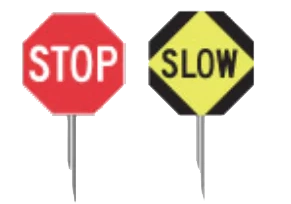Stop/Slow Paddle Sign
-
 CDE
CDE - Update on. 23 Apr, 2025

Introduction
The Stop/Slow paddle sign is a key traffic control tool used in construction zones and temporary traffic control areas. These signs are operated by traffic control personnel, also known as flaggers, to ensure safe movement around roadwork. Recognizing these signs is crucial for passing your Ontario G1 driving test and for safe driving near work zones.
What Do the Stop/Slow Paddle Signs Mean?
-
STOP (Red Octagon):
Drivers must come to a complete stop. Wait for the signal to proceed. -
SLOW (Yellow Diamond):
Reduce speed and proceed with caution. Watch for workers, equipment, or oncoming traffic.
Where Are These Signs Used?
You’ll commonly find these signs:
-
At road construction sites
-
During lane closures or detours
-
Where flaggers control traffic flow
-
In temporary alternating traffic scenarios (e.g., one lane for two-way traffic)
How Should Drivers Respond?
-
Follow the direction given by the sign holder (flagger)
-
Stop completely when the stop sign is displayed
-
Proceed slowly and carefully when the slow sign is shown
-
Stay alert for changes in direction or hand signals
Visual Representation
-
The STOP side is a red octagon with white text
-
The SLOW side is a yellow diamond with black text
-
Both signs are mounted on a handheld paddle used by flaggers
Conclusion
The Stop/Slow paddle sign ensures safety for both drivers and road workers in construction zones. Understanding how to respond to these signs is essential for responsible driving and is part of what you’ll be tested on in your G1 exam. Always drive attentively in work areas and obey the flaggers without hesitation.

Please Comment Below